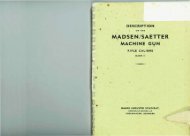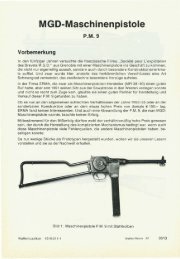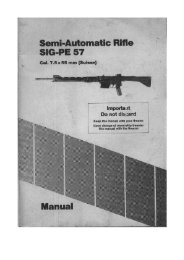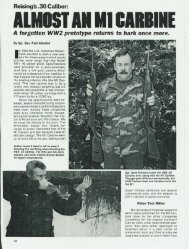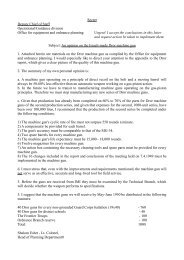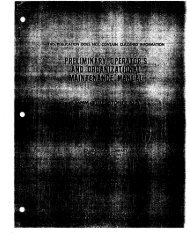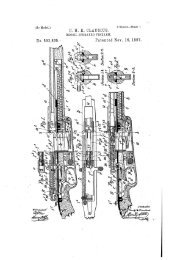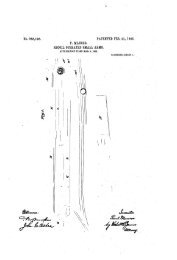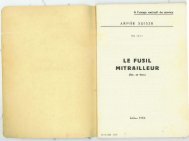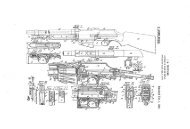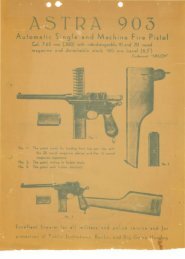TM 9-1005-208-35 M1918A2 BAR.pdf - Forgotten Weapons
TM 9-1005-208-35 M1918A2 BAR.pdf - Forgotten Weapons
TM 9-1005-208-35 M1918A2 BAR.pdf - Forgotten Weapons
Create successful ePaper yourself
Turn your PDF publications into a flip-book with our unique Google optimized e-Paper software.
Code Recoverability Aspect<br />
exchange basis. When items are determined by a<br />
GSU to be uneconomically repairable, they will be<br />
evacuated to a depot for evaluation and analysis<br />
before final disposition.<br />
T High dollar value recoverable repair parts which<br />
are subject to special handling and are issued on<br />
an exchange basis. Such repair parts are normally<br />
repaired or overhauled at depot maintenance<br />
activities.<br />
U Repair parts specifically selected for salvage by<br />
reclamation units because of precious metal<br />
content, critical materials, high dollar value<br />
reusable casings, or castings<br />
No Code Parts will be considered expendable. Indicated<br />
b. Federal Stock Number, Column 2. This<br />
column indicates the Federal stock number assigned<br />
to the item and will be used for requisitioning<br />
purposes.<br />
c. Description, Column 3. This column<br />
indicates the Federal item name and any additional<br />
description of the item required. The abbreviation<br />
"w /e" when used as a part of the nomenclature,<br />
indicates the Federal stock number includes all<br />
armament, equipment, accessories, and repair parts<br />
issued with the item. A part number or other<br />
reference number is followed by the applicable<br />
fivedigit Federal supply code for manufacturers in<br />
parentheses. Repair parts quantities included in the<br />
kits, sets, and assemblies are shown in front of the<br />
repair part name.<br />
d. Unit of Measure (U/M), Column 4. A 2<br />
character alphabetic abbreviation indicating the<br />
amount or quantity of the item upon which the<br />
allowances are based, e.g., ft, ea, pr, etc.<br />
e. Quantity Incorporated in Unit, Column 5.<br />
This column indicates the quantity of the item used<br />
in a functional group or assembly. A "V" appearing<br />
in this column in lieu of a quantity indicates that a<br />
definite quantity cannot be indicated (e.g., shims,<br />
spacers, etc).<br />
f. 30 Day DS/GS Maintenance Allowances,<br />
Column 6 and 7. Note. Allowances in GS column<br />
are for GS maintenance only.<br />
(1) The allowance columns are divided<br />
into three subcolumns. Indicated in each<br />
subcolumn, opposite the first appearance of each<br />
item, is the total quantity of items authorized for the<br />
number of equipments supported. Subsequent<br />
appearances of the same item will have the letters<br />
"REF" in the applicable allowance columns. Items<br />
authorized for use as required but not for initial<br />
stockage are identified with an asterisk in the<br />
allowance column.<br />
(2) The quantitative allowances for<br />
DS/GS levels of maintenance will represent initial<br />
stockage for a 30-day period for the number of<br />
equipments<br />
supported.<br />
31<br />
<strong>TM</strong> 9-<strong>1005</strong>-<strong>208</strong>-<strong>35</strong><br />
(3) Determination of the total quantity<br />
of parts required for maintenance of more than 100<br />
of these equipments can be accomplished by<br />
converting the equipment quantity to a decimal<br />
factor by placing a decimal point before the next to<br />
last digit of the number to indicate hundredths, and<br />
multiplying the decimal factor by the parts quantity<br />
authorized in the 51-100 allowance column.<br />
Example, authorized allowance for 51-100<br />
equipments is 40; for 150 equipments multiply 40 by<br />
1.50 or 60 parts required.<br />
g. 1 Year Allowances Per 100<br />
Equipments/Contingency Planning Purposes,<br />
Column 8. This column indicates opposite the first<br />
appearance of each item the total quantity required<br />
for distribution and contingency planning purposes.<br />
The range of items indicates total quantities of all<br />
authorized items required to provide for adequate<br />
support of 100 equipments for one year.<br />
h. Depot Maintenance Allowance Per 100<br />
Equipments, Column 9. This column indicates<br />
opposite the first appearance of each item, the total<br />
quantity authorized for depot maintenance of 100<br />
equipments. Subsequent appearances of the same<br />
item will have the letters "REF" in the allowance<br />
column. Items authorized for use as required but<br />
not for initial stockage are identified with an asterisk<br />
in the allowance column.<br />
i. Illustration, Column 10. This column is<br />
divided as follows:<br />
(1) Figure Number, Column 10a.<br />
Indicates the figure number of the illustration in<br />
which the item is shown.<br />
(2) Item Number, Column 10b.<br />
Indicates the callout number used to reference the<br />
item in the illustration.<br />
B-4. How to Locate Repair Parts<br />
a. When Federal stock number or reference<br />
number is unknown:<br />
(1) First. Using the table of contents,<br />
determine the functional group or assembly within<br />
which the repair part belongs. This is necessary<br />
since the illustrations are prepared for functional<br />
groups or assemblies and listings are divided into<br />
the same groups.<br />
(2) Second. Find the illustration<br />
covering the functional group or assembly to which<br />
the repair part belongs.<br />
(3) Third. Identify the repair part on the<br />
illustration and note the illustration figure and item<br />
number of the repair part.<br />
(4) Fourth. Using the Repair Parts<br />
Listing find the functional group or assembly to<br />
which the repair part belongs and locate the<br />
illustration figure and item number noted on the<br />
illustration.<br />
b. When the Federal stock number or<br />
reference number is known:<br />
(1) First. Using the Index of Federal<br />
Stock




